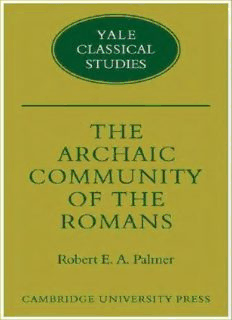
The Archaic Community of the Romans (Yale Classical Studies) PDF
Preview The Archaic Community of the Romans (Yale Classical Studies)
THE ARCHAIC COMMUNITY OF THE ROMANS THE ARCHAIC COMMUNITY OF THE ROMANS BY ROBERT E.A. PALMER Department of Classical Studies University of Pennsylvania CAMBRIDGE AT THE UNIVERSITY PRESS 1970 Published by the Syndics of the Cambridge University Press Bentley House, 200 Euston Road, London N.W.i American Branch: 32 East 57th Street, New York, N.Y. 10022 Library of Congress Catalogue Card Number: 77-92252 I.S.B.N. : o 521 07702 8 Printed in Great Britain by Alden & Mowbray Ltd at the Alden Press, Oxford PARENTIBVS OPTIMIS ROBERT E. A. PALMER JOSEPHINE SCHREIBER PALMER CONTENTS Preface page ix List of abbreviations xi 1 THE PROBLEM I 2 THREE, THIRTY AND THREE HUNDRED 5 3 VARRO's SQUARED COLONY 26 4 OTHER SYSTEMS 35 The Israelite System 35 Hellenic Systems 37 The Etruscan Systems 38 The Iguvine System 40 German Systems 57 Non-Roman Curias 59 Conclusion 65 5 WHAT WAS A CURIA? 67 Definitions of a Curia 67 Curias' Proper Names 75 6 GURIAL ORIGINS AND RELIGION 8o Old and New Curias 82 The Twenty-Seven Argei 84 Feasts and Flamens 97 The Seven Hills 122 'Kinds of Romans' 132 Curial Lands 141 The Thirty Curias and Three Tribes 152 Quirites 156 Quirinus 160 Conclusion 172 CONTENTS 7 ROMAN CURIAS AND THE LATIN FESTIVAL 176 8 COMMUNION AND COMMUNITY l8o Evocation 180 The Communion of Earth 181 The Curiate Law 184 9 THE CURIATE CONSTITUTION l8g The Curiate Civil System 191 'Patres, Patricii, Plebs' 197 Procedure in the Curiate Assembly 202 The Powers of the Curiate Assembly 213 Some Republican Interregna 226 The Consular Tribunate 232 The Fathers and the Plebs 243 The New Senate 253 The Deterioration of Patrician Domination 269 Conclusion 276 IO A SUMMARY OF THE CURIATE CONSTITUTION 282 APPENDICES I REVISED FASTI OF YEARS WITH EPONYMOUS TRIBUNES-CONSUL 288 II IMPERIAL FAMILIES WITHOUT RECORD BETWEEN 444 AND 366 B.C. 289 III THE PATRICIATE 29O A. Imperial Families Between 444 and 367 B.c. 297 B. Families not Imperial before 444 B.c. 299 c. Officeholding from 444 to 366 B.C. According to Status 299 D. Families elected in the Centuriate Assembly 300 E. Participation in Magistracies according to Status 300 F. List of known Interrexes from 509 to 52 B.C. 300 Bibliography 303 MAPS 1 Old Latium 307 2 Old Rome 308 3 Center of Old Rome 309 Index 311 PREFACE During the academic year 1963-4 I gave a graduate course on the archaic history of Rome while I continued research into the history of Roman vici. Since the latter organization supplied a means of integrating non-Romans into the life of the City, I asked myself how the Romans had absorbed the outsider before the development of its urban vici. I suspected that the word vicus implied the 'pre-urban' communities which later came to be known as Rome. However, the urban vici have yielded no certain evidence of an organization that might have served as a vehicle for the formation of historical Rome. Nevertheless before the year was passed I believed that the answer to my question lay in the nature of the obscure Roman curias and their assembly. With a grant from the University of Pennsylvania I spent a summer of research in Rome and began writing what I thought would be an article or two on the curias which could serve to clarify my own ideas on integration in early Rome and to break a path for my thesis on the nature and origin of urban vici. Four years later the work in hand was a finished book. In the help of my friends I have been singularly fortunate. Some parts of the book have been read by T. R. S. Broughton, H. M. Hoenigswald, A. D. Momigliano, J. H. Oliver and J. W. Poultney. All of them made contributions to its improvement. In personal con versation I have learned from L. W. Daly, R. M. Ogilvie, M. Ostwald and L. R. Taylor. None who shared his knowledge with me is responsible for the conclusions reached in the following essay. In attempting to elucidate the earliest history of Rome I have not mastered all that has been written before me. No doubt I have even overlooked acknowledgement to my predecessors on some points. On the other hand, I hope that I have omitted no piece of ancient evi dence having importance for my work. I have tried to take into consideration contemporary essays on the history and structure of early Rome. In such work as ours theory easily supplants the missing facts. I have not wished to gainsay or argue with those who are or have recently been engaged in this common pursuit. Thus I have not put before the reader every recent theory on early Rome only to IX
Description: